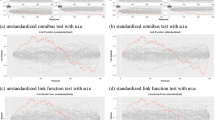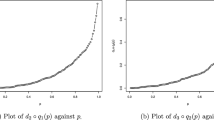Abstract
One of the greatest challenges related to the use of piecewise exponential models (PEMs) is to find an adequate grid of time-points needed in its construction. In general, the number of intervals in such a grid and the position of their endpoints are ad-hoc choices. We extend previous works by introducing a full Bayesian approach for the piecewise exponential model in which the grid of time-points (and, consequently, the endpoints and the number of intervals) is random. We estimate the failure rates using the proposed procedure and compare the results with the non-parametric piecewise exponential estimates. Estimates for the survival function using the most probable partition are compared with the Kaplan–Meier estimators (KMEs). A sensitivity analysis for the proposed model is provided considering different prior specifications for the failure rates and for the grid. We also evaluate the effect of different percentage of censoring observations in the estimates. An application to a real data set is also provided. We notice that the posteriors are strongly influenced by prior specifications, mainly for the failure rates parameters. Thus, the priors must be fairly built, say, really disclosing the expert prior opinion.
Similar content being viewed by others
References
Aitkin M, Laird N, Francis B (1983) A reanalysis of the Stanford heart transplant data (with discussion).. J Am Stat Assoc 78: 264–292
Barbosa EP, Colosimo EA, Louzada-Neto F (1996) Accelerated life tests analyzed by a Piecewise exponential distribution via generalized linear models. IEEE Trans Reliab 45: 619–623
Barry D, Hartigan JA (1992) Product partition models for change point problems. Ann Statist 20: 260–279
Barry D, Hartigan JA (1993) A Bayesian analysis for change point problem. J Am Statist Assoc 88: 309–319
Bastos LB, Gamerman D (2006) Dynamic survival models with spatial frailty. Lifetime Data Anal 12: 441–460
Breslow N (1974) Covariance analysis of censored survival data. Biometrics 30: 34–41
Chen MH, Ibrahim JG (2001) Maximum likelihood methods for cure rate models with missing covariates. Biometrics 57: 43–52
Clark DE, Ryan LM (2002) Concurrent prediction of hospital mortality and length of stay from risk factors on admission. Health Services Res 37: 631–645
Doornik JA (1990) Ox: an object-oriented matrix language. Timberlake Consultants Press, London
Fearnhead P (2006) Exact and efficient Bayesian inference for multiple change point problems. Statist Comput 16: 203–213
Friedman M (1982) Piecewise exponential models for survival data with covariates. Ann Statist 10: 101–113
Gamerman D (1994) Bayes estimation of the piece-wise exponential distribution. IEEE Trans Reliab 43: 128–131
Gamerman D (1991) Dynamic Bayesian models for survival data. Appl Statist 40: 63–79
Gustafson P, Aeschliman D, Levy AR (2003) A simple approach to fitting Bayesian survival models. Lifetime Data Anal 9: 5–19
Holford TR (1976) Life tables with concomitant information. Biometrics 32: 587–598
Ibrahim JG, Chen MH, Sinha D (2001) Bayesian survival analysis. Springer, New York
Kim JA, Proschan F (1991) Piecewise exponential estimator of the survivor function. IEEE Trans Reliab 40: 134–139
Kim S, Chen MH, Dey DK, Gamerman D (2007) Bayesian dynamic models for survival data with cure fraction. Lifetime Data Anal 13: 17–35
Loschi RH, Cruz FRB (2005) Extension to the product partition model: Computing the probability of a change. Comput Statist Data Anal 48: 255–268
Loschi RH, Cruz FRB, Iglesias PL, Arellano-Valle RB (2003) A Gibbs sampling scheme to the product partition model: an application to change-point problems. Comput Oper Res 30: 463–482
Qiou Z, Ravishanker N, Dey DK (1999) Multivariate survival analysis with positive stable frailties. Biometrics 55: 637–644
Quintana FA, Iglesias PL (2003) Nonparametric Bayesian clustering and product partition models. J Roy Stat Soc Ser B 65: 557–574
Rigdon SE, Basu AP (2000) Statistical methods for the reliability of repairable systems. Wiley, New York
Sahu SK, Dey DK, Aslanidou H, Sinha D (1997) A Weibull regression model with gamma frailties for multivariate survival data. Lifetime Data Anal 3: 123–137
Yao Y (1984) Estimation of a noisy discrete-time step function: Bayes and empirical Bayes approaches. Ann Statist 12: 1434–1447
Author information
Authors and Affiliations
Corresponding author
Rights and permissions
About this article
Cite this article
Demarqui, F.N., Loschi, R.H. & Colosimo, E.A. Estimating the grid of time-points for the piecewise exponential model. Lifetime Data Anal 14, 333–356 (2008). https://doi.org/10.1007/s10985-008-9086-0
Received:
Accepted:
Published:
Issue Date:
DOI: https://doi.org/10.1007/s10985-008-9086-0




